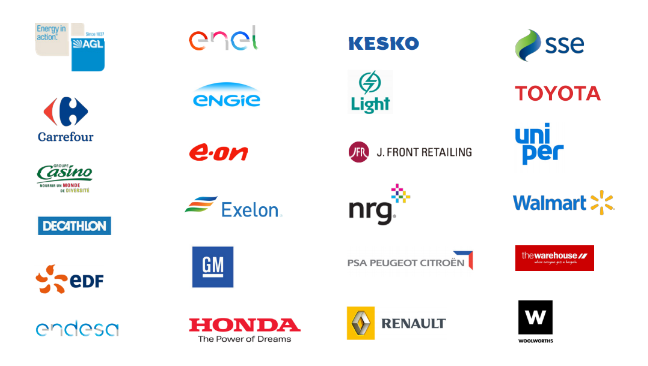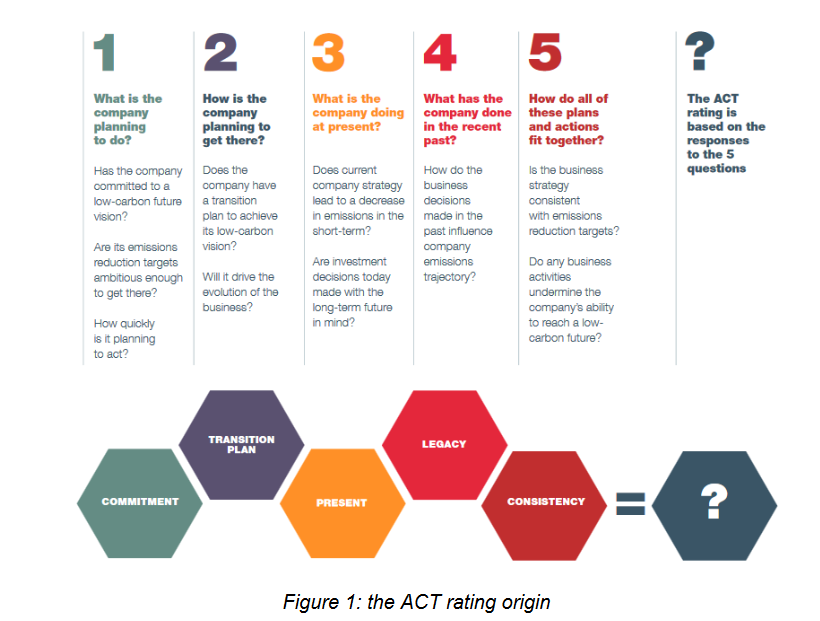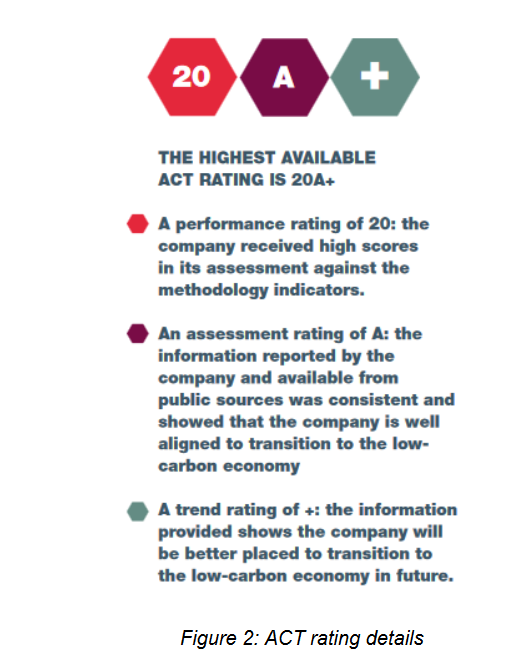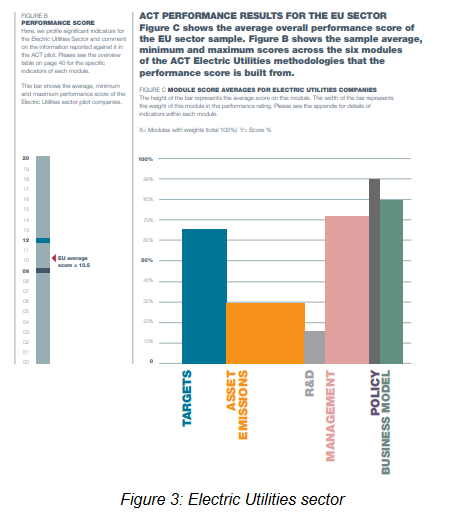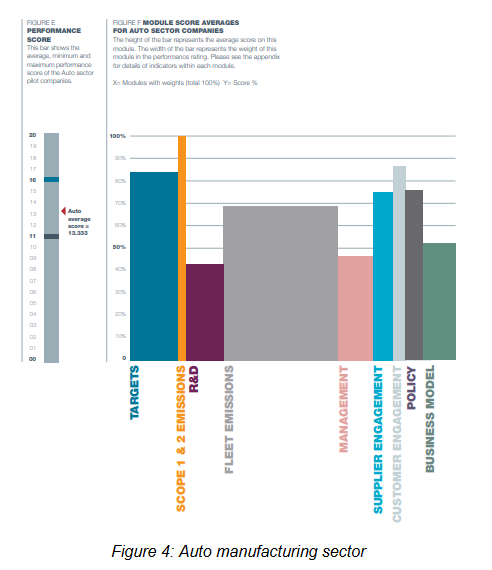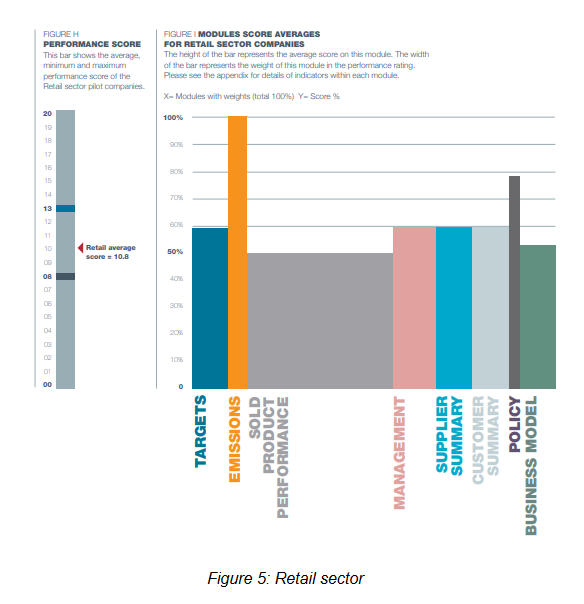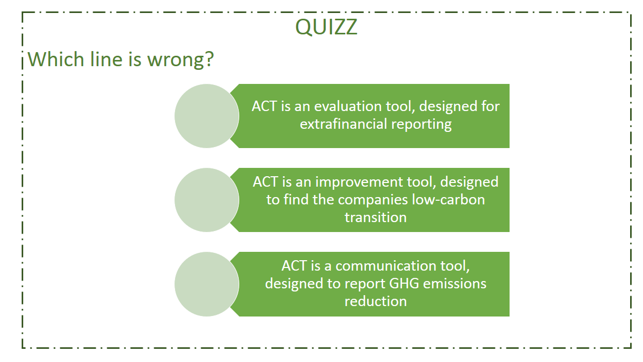International ACT experimentation: CDP, extra-financial reporting, what sectors & why, results
Presentation of the Act Pilot project
The ACT (Assessing low-Carbon Transition) initiative assesses how ready an organization is to change toward a new low-carbon world, using a future-oriented, sector specific methodology.
ADEME and CDP partnered with 2DII, EIB and ClimateCHECK for the ACT pilot project, which launched at COP21 in Paris and developed three methodologies to assess alignment with low-carbon transition in the Electric Utilities, the Auto Manufacturing and the Retail sectors.
The methodologies were developed in consultation with companies and experts in these sectors, and pilot companies reported against the methodologies and received an ACT pilot assessment and rating in confidence. Feedback received during the course of the pilot influenced the development of the methodologies and will be fed in to future methodology development.
ACT methodologies are sector specific, because the contributions of each sector differ greatly, and different actions will be required of different sectors as they play their part in the transition to the low carbon economy. The three sectors chosen for the pilot typify a range of challenges companies will face during the transition to the low carbon economy. The approaches developed for these sectors during the pilot will be applicable to other sector methodologies in future.
Pilot Companies
ACT framework
As a starting point, the ACT methodology developers posed five guiding questions about the company alignment with low carbon transition. The five questions became the basis of a framework to steer the development of the ACT methodologies.
These five questions are linked to the company’s investments, actions, and strategy. A set of indicators were developed for each sector to benchmark a state of alignment with low-carbon transition, and measure how far away companies are from that state.
However, the framework remains the same for the development of each methodology. Companies reporting against these indicators can be assessed against the benchmark to produce an ACT rating. A table summarizing the indicators in each sector methodology is available in the appendix of this report.
ACT Rating
The ACT rating consists of three elements:
-
A Performance Rating, represented as a number from 1 up to 20
-
An Assessment Rating, represented as a letter from A down to E
-
A Trend Rating, represented as +, improving; -, worsening; or =, stable.
The sectors concerned by the project (and results)
Electric utilities
The Electric Utilities sector is one of the major contributors to climate change, representing around 25% of annual global emissions. The International Energy Agency produces an annual Energy Technology Perspectives (IEA, ETP) report which analyses what new technology developments are required per sector in order to achieve a 2° degree climate scenario.
To assess companies in the electric utilities sector, the ACT methodology considers in detail each company’s asset portfolio and what that might mean for the future of the company.
The ACT Electric Utilities sector pilot reveals that the pilot companies are ahead concerning climate change strategy and planning for a low-carbon future. Nonetheless, actual performance in terms of transforming their generation portfolio away from fossil generation is lagging behind this picture, with some utilities at risk of not staying within their carbon budget without additional action.
At the strategic level, the companies assessed show a strong alignment with the requirements of low-carbon transition. It is a good news, because the Electric Utilities sector needs to decarbonise in order to enable a transition in many other energy-intensive sectors.
Adding more renewable energy capacity will bring the companies closer to the possibility of reaching a low-carbon future state. But a complete shift from fossil to renewable has not yet been translated into tangible results, even in the pilot companies.
Auto
The transport sector represents almost 14% of all emissions from fossil fuels, and is therefore a significant contributor to climate change. Transport by car constitutes the dominant mode of passenger transportation globally, and emissions from the use of light-duty vehicles need to reduce by 58% between 2010 and 2050, which translates to a reduction of 76% in emissions per kilometre driven. This will come from both reduction of vehicle emissions and shifting passenger journeys away from personal car travel. Decarbonization of the auto sector will not only require technology changes in drivetrain and energy sources, but a reshaping of the global infrastructure that supports vehicle refuelling.
While the Electric Utility sample quite consistently showed high management scores, this is not the case for the Auto sector.
Fleet emissions indicators are the most heavily weighted in the assessment, but ACT also seeks a clear strategic focus on reducing fleet emissions via strategy-related indicators on management and business model; as well as customer, supplier and policymaker engagement.
The absolute emissions from road vehicles can no longer increase after 2030, and therefore during this time, all car companies need to pivot their business model to one dominated by sales of low-carbon vehicles.
Retail
The majority of emissions attributable to the retail sector are not emitted through a company’s own operations, but rather from throughout the value chain. A low-carbon transition towards a 2-degree alignment by 2050 will require a transformation not only of the retail sector, but of its whole value chain, from upstream production to downstream use and disposal of products.
The pilot companies for the Retail sector show a strong performance for their scope 1 and 2 emissions reductions and their policy engagement, but this is not carried over to their sold product performance and future business model results.
This indicates that although the pilot companies are excelling on reducing their operational emissions, for example from transport or refrigerant leakages in the case of food retailers, they are struggling to translate this expertise to reduce their value chain emissions.
Retailers will be a critical actor in the development of a circular, low-carbon economy as they can exert influence throughout the length of complex supply chains, and shifting customer choices and behaviour.
Effectively reducing emissions in the value chain means going beyond collaboration to work on a basis of shared accountability. All stakeholders must recognise the need to work together and hold each other accountable for taking action to reduce emissions.
Extra-financial reporting
Analysts could use the detailed results of company assessments when engaging with companies on their preparedness for transition to the low-carbon economy.
For example, benchmark levels for a company to achieve could be developed; or areas of strength or concern identified in the course of the assessment could be followed up on. ACT assessment results could inform asset allocation decisions, or be incorporated into investment analysis. Rating agencies could also use ACT methodologies to provide a climate performance element to their own decisions.
To see the answer of the quizz, just move the mouse over the picture!
See the next page "French SME ACT experimentation" or return to the menu.

